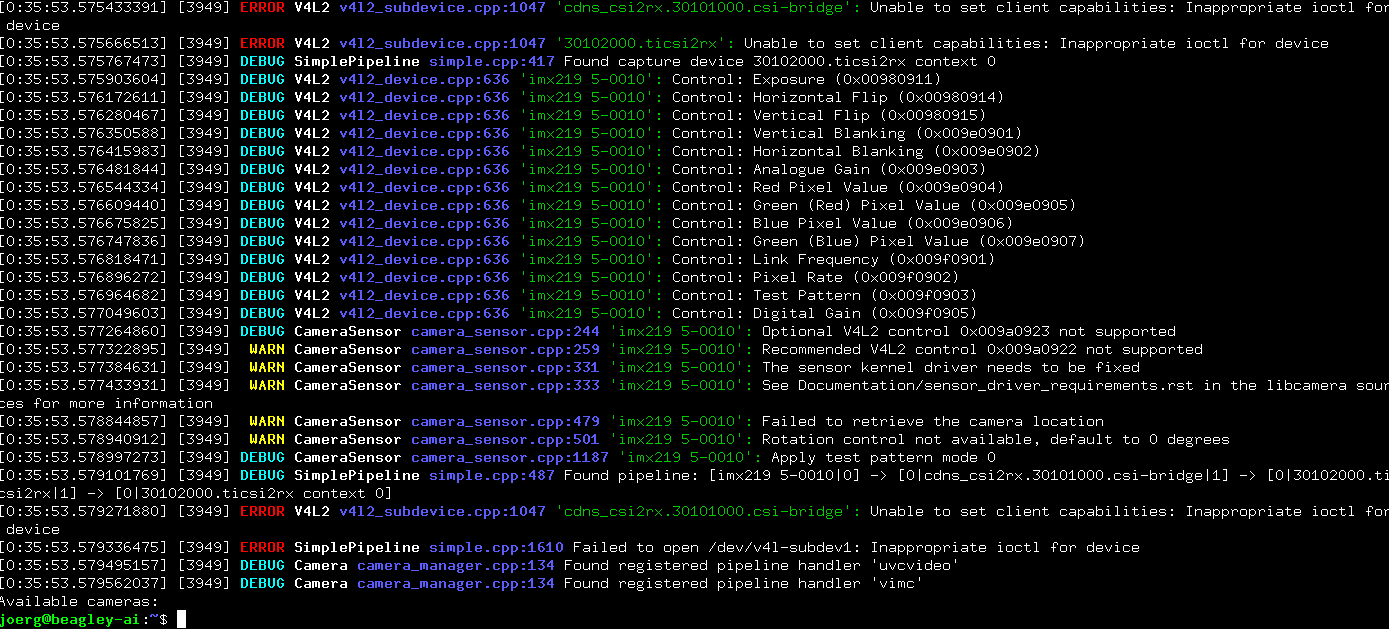Hello,
I am trying to make the Sony IMX219-based camera (RPi Camera Module 2 NoIR) work with BeagleY-AI board.
After adding the overlay reference in the /boot/firmware/extlinux/extlinux.conf file as
label microSD (default)
kernel /Image
append console=ttyS2,115200n8 root=/dev/mmcblk1p3 ro rootfstype=ext4 resume=/dev/mmcblk1p2 rootwait net.ifnames=0 quiet
fdtdir /
fdt /ti/k3-am67a-beagley-ai.dtb
fdtoverlays /overlays/k3-am67a-beagley-ai-csi0-imx219.dtbo
#initrd /initrd.img
rebooting, and running sudo beagle-camera-setup, the camera is detected
$ sudo beagle-camera-setup
IMX219 Camera 0 detected
device = /dev/video-imx219-cam0
name = imx219
format = [fmt:SRGGB8_1X8/1920x1080]
subdev_id = /dev/v4l-imx219-subdev0
isp_required = yes
and appears in /dev/
$ ls -l /dev/ | grep video
...
crw-rw---- 1 root video 81, 11 Feb 18 22:43 v4l-subdev2
lrwxrwxrwx 1 root root 11 Feb 18 22:50 video-imx219-cam0 -> /dev/video3
crw-rw---- 1 root video 81, 0 Feb 18 22:43 video0
crw-rw---- 1 root video 81, 1 Feb 18 22:43 video1
crw-rw---- 1 root video 81, 2 Feb 18 22:43 video2
crw-rw---- 1 root video 81, 3 Feb 18 22:43 video3
...
However, when I run a simple test
v4l2-ctl --device /dev/video-imx219-cam0 \
--set-fmt-video=width=1920,height=1080,pixelformat=YUYV \
--stream-mmap --stream-count=50 \
--stream-to=out.yuv
the command hangs indefinitely, and the output file out.yuv is empty.
(The same result is with --device /dev/video3).
Similarly, GStreamer hangs:
gst-launch-1.0 \
v4l2src device=/dev/video-imx219-cam0 num-buffers=100 ! \
videoconvert ! \
x264enc tune=zerolatency bitrate=500 speed-preset=superfast ! \
mp4mux ! \
filesink location=output.mp4
…
The dmesg | grep imx219 command produces:
[ 6.685482] imx219 5-0010: supply VANA not found, using dummy regulator
[ 6.716700] imx219 5-0010: supply VDIG not found, using dummy regulator
[ 6.721153] imx219 5-0010: supply VDDL not found, using dummy regulator
[ 9.613736] imx219 5-0010: Consider updating driver imx219 to match on endpoints
[ 11.768522] Modules linked in: ... imx219 ...
[ 11.769904] Modules linked in: ... imx219 ...
I’ve tried editing the k3-am67a-beagley-ai-csi0-imx219-new.dts file (decompiled from and recompiled to the corresponding .dtbo), but no success so far. Any ideas of how to proceed from there?
